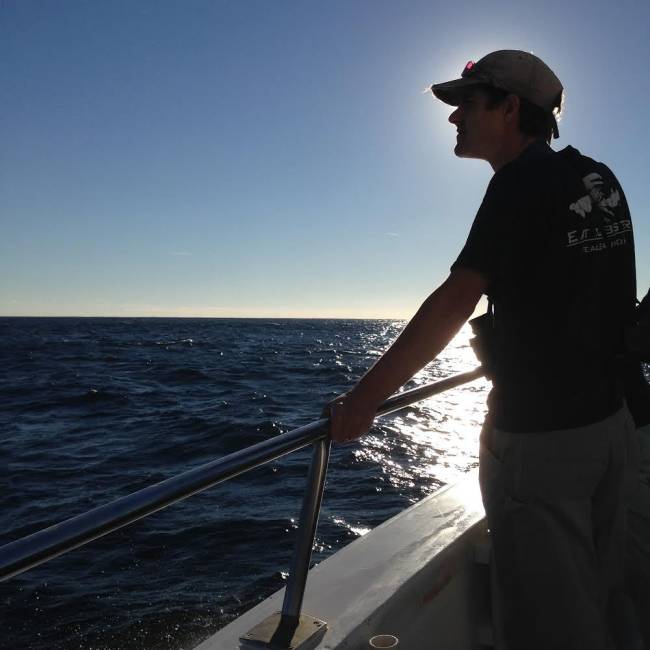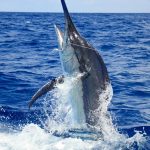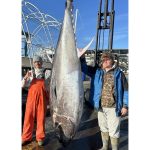Article courtesy of northjersey.com // By James M. O’Neill // January 4, 2015 – please click here for original article.
Above: Malin Pinsky, a marine biologist with Rutgers University, has studied how rising ocean temperatures have affected the commercial and recreational fishing industries off the Jersey Shore. Image courtesy of Patrick Flanagan/Special to the Record.
A dramatic rise in ocean temperature is changing the kinds of fish that swim off New Jersey’s coast — a development that has significant ramifications for the state’s fishing industry and could even alter restaurant menus.
Species that used to be centered off New Jersey, like shad, have shifted north to New England in search of cooler waters. Fish once centered off Virginia, like black sea bass and summer flounder, now swim in abundance off New Jersey.
“We’ve been seeing unprecedented warming in the ocean over the past several decades,” said Malin Pinsky, a marine biologist at Rutgers University who has studied the changes. “Climate change and the warming of ocean waters is not some abstract global problem. We can see the implications right off our shore in New Jersey.”
Temperatures had risen one degree every 14 years off New Jersey since the 1970s. In the past decade, warming has accelerated to one degree every 2½ years, Pinsky said.
“Marine fish are very sensitive to a change in temperature — they can only survive in a narrow range, so they are seeking out cooler waters toward the poles and deeper in the ocean,” he said. “And deeper generally means farther from shore.”
As the species shift north, fishing industries are hampered in making adjustments because federal fishing quotas that determine how much of each species can be caught are based on decades-old data.
“The regulations haven’t kept up with the shift in fish populations,” Pinsky said. “The regulations are based on the idea that fish distributions are static. There are state-by-state allocations.”
The shifting of species has created hurdles for the commercial fishing industry — but could pose new opportunities down the road if the regulations are altered, experts say.
Consider the black sea bass. In the late 1960s, populations were centered off Virginia. By 2012, the species was centered off New Jersey. But Virginia still has the largest quota for taking black sea bass, Pinsky said.
Commercial boats from Southern states in search of black sea bass travel up to New Jersey waters. But to land and sell the fish under their Southern state permits, they must bring their catch back to Virginia or North Carolina. “That costs a lot in fuel,” said Jeff Kaelin, who handles fisheries management issues at Lund’s Fisheries, based in Cape May.
Commercial fishermen are looking to have rules changed so they can land fish where they catch them, then use trucks to get the fish back to the states where the permits were issued. “It would be cheaper than by boat and it takes less time,” Kaelin said.
Meanwhile, increasing New Jersey’s quotas for the newly abundant species off its coast could mean greater profit for the state’s fishing industry. “Black sea bass is very tasty, and we are seeing it already on restaurant menus here,” Pinsky said. “I’m sure we’ll see continued changes in what shows up on our plates.”
The Atlantic States Marine Fisheries Commission oversees fisheries in state waters and is looking at the impact of climate change on fish species. “There’s clearly new science out there,” said Tina Berger, the commission’s spokeswoman. “There’s a general belief that some species are shifting northward. We’re committed to looking at potential changes to allocations to summer flounder, and later for black sea bass.”
Kaelin, who also serves as New Jersey’s representative on the Mid-Atlantic Fishery Management Council, said he expected changes would be made to the states’ allocations, but not overnight. “It will be a couple of more years,” he said. “There’s a lot of research going on, and species distribution is definitely an issue, but I think the jury is still out about which fish species are moving and what the reasons are. There’s no question that in the last several years the ocean temperature has been increasing dramatically. But it’s hard to predict what to do about it as a fishery manager. That’s why Malin’s work is important — he’s helping the fishery managers better understand the climate issue.”
He said the agencies that control state allocations still need better data. For instance, black sea bass numbers are probably much higher than surveys indicate, and with allocations still low, commercial and recreational fishing boats are forced to throw a lot of caught fish overboard, he said. Many of those discarded fish don’t survive, resulting in a wasted resource.
Fish surveys, used to determine quotas, are made in the same locations every year — in each species’ historical habitat. Shifting populations affect the accuracy of population estimates, Kaelin said.
In 2013, Josh Kohut, another Rutgers researcher, was part of a team that created a better modeling system to more accurately determine the population distribution of the Atlantic butterfish. The new model indicated the butterfish population can support a quota of 20,000 metric tons; the prior quota was 1,500 metric tons. (A metric ton is about 2205 pounds.)
This change can result in economic benefits for the local fishery industry, since it now has a quota high enough to maintain local markets and support the development of international markets, according to the National Oceanic and Atmospheric Administration.
Even as new species enter New Jersey waters, species that used to be centered here are leaving. For instance, American shad, centered off Sandy Hook in 1971, has shifted up to Rockport, Mass. The American lobster, centered off Long Branch in 1970, is now centered off Salem, Mass.
The data for many species is available on a website, OceanAdapt.rutgers.edu, built by Pinsky and his colleagues and financed by the U.S. National Marine Fisheries Service.
Instead of following the fish they used to catch, local fishermen may switch to the new species entering their states’ waters. “Switching will make sense, especially for smaller boats,” Pinsky said.
In other cases, it’s harder to transition to new gear or develop new markets for unfamiliar species. For instance, red hake, once centered off New Jersey, is now centered off Boston, “but there’s not much of a market for red hake in New England,” Pinsky said. While there’s demand for the fish in New York, the fish doesn’t travel well. And the nets used to catch red hake could accidentally entrap cod, a species affected by overfishing; the nets for red hake could therefore interfere with efforts to rebuild the cod fishery, Pinsky said.
Shifting has also affected New Jersey’s recreational fishing industry. Summer flounder, or fluke, is an example.
“Over the past seven years we’ve seen a real shift from south to north,” said Greg Hueth, chairman of Save the Summer Flounder Fishery Fund. New Jersey’s summer flounder season used to start in June. Now the species appears in May — lengthening the season.
“The fluke fishery in New Jersey is as big as it has ever been,” Hueth said. “That’s the species everybody’s fishing for.”
During the season there might be as many as 250 boats around Shrewsbury Rocks — a rock pile off Sea Bright favored by fluke. “We have seen better participation on day-trip party boats,” Hueth said.






